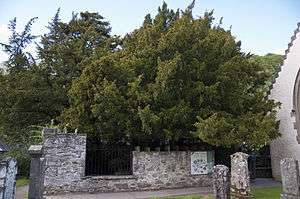Fortingall Yew

The Fortingall Yew is an ancient European yew (Taxus baccata) in the churchyard of the village of Fortingall in Perthshire, Scotland. Modern expert estimates have put its age at between 2,000 and 3,000 years. It may be the oldest tree in Britain.
Age
Modern expert estimates put the age of the tree at between 2,000 and 3,000 years, although it may be a remnant of a post-Roman Christian site and around 1,500 years old.[1] Others have suggested an age as great as 5,000 to 9,000 years. This still makes it one of the oldest known trees in Europe,[2] although the root system of the Norway spruce Old Tjikko in Sweden is at least 9,500 years old.[3] The Fortingall Yew is possibly the oldest tree in Britain.[1]
The tree

The tree's once massive trunk (16 metres, or 52 feet in girth when it was first taken notice of in writing, in 1769[4]) with a former head of unknown original height, is split into several separate stems, giving the impression of several smaller trees, with loss of the heartwood rings that would establish its true age.[5] This is a result of the natural decay of the ancient heartwood, which reduced the centre of the trunk down to ground level by 1770.[6] Other than this, the tree is still in good health, and may last for many more centuries. By 1833 it was noted that "large arms had been removed and even masses of the trunk, carried off, to make drinking-cups and other curiosities."[7] It is protected by a low wall erected in 1785[8] to preserve it but it can still be easily viewed. The yew is male,[9] however in 2015 scientists from the Royal Botanic Garden in Edinburgh reported that one small branch on the outer part of the crown had changed sex and begun to bear a small group of berries - an occurrence occasionally noted in conifers.[10][11] The seeds have been preserved for study and will be used to help maintain genetic diversity in yews.[12]
Clippings from the tree are to be taken to the Royal Botanic Gardens, Edinburgh, to form part of a mile-long hedge. The purpose of this "Yew Conservation Hedge Project" is to maintain the DNA of Taxus baccata from ancient specimens in the UK as, worldwide, the trees are threatened by felling and disease.[13]
History
The area immediately surrounding Fortingall has a variety of prehistoric archaeological sites including Càrn na Marbh, a Bronze Age tumulus. Place-name and archaeological evidence hint at an Iron Age cult centre at Fortingall, which may have had this tree as its focus.[9] The site was Christianised during the Dark Ages, with the yew already full grown, perhaps because it was already a sacred place. A recollection of 1804 noted that "the boys of the village" had damaged the yew "kindling their fire of Bealltuinn at its root."[14]
Rev. James MacGregor, author of the Book of the Dean of Lismore was a minister in the church during the 16th century.[15]
Legend
According to local legend, Pontius Pilate was born in its shade and played there as a child.[16]
See also
Notes
- 1 2 Bevan (2004) pp. 38–39
- ↑ "Wanted: Fat, old, gnarled trees" (28 June 2007) Telegraph.co.uk. Retrieved on 29 September 2007. "The Fortingall Yew near Callendar in Scotland - believed to be the oldest tree in the UK and possibly Europe."
- ↑ Owen, James. "Oldest Living Tree Found in Sweden". National Geographic. Retrieved 2008-05-06.
- ↑ Hon. Daines Barrington, Transactions of the Royal Society, 1769.
- ↑ This is also true of the Llangernyw Yew in North Wales.
- ↑ Notice by Thomas Pennant, who measured the girth at 56½ feet, and noted that within living memory the heartwood had conjoined the trunks at a height of three feet (noted by Lindsay 1884:221).
- ↑ Patrick Neill, in Edinburgh New Philosophical Journal, noted in Lindsay.
- ↑ "By the father of Dr. Irvine of Pitlochry" according to Lindsay.
- 1 2 Meredith, Allen (1986). "A Living Legend" (PDF). ancient-yew.org. Retrieved 13 October 2013.
- ↑ Coleman, Max. "Oldest yew tree switches sex". Botanics Stories. Royal Botanic Garden Edinburgh. Retrieved 2 November 2015.
- ↑ Gosden, Emily (1 November 2015). "Britain's oldest tree appears to be undergoing a sex change after 3,000 years". The Daily Telegraph. Retrieved 2 November 2015.
- ↑ Berries show ancient Fortingall yew tree is 'changing sex'
- ↑ Ross, Shan (7 November 2008) "You may not be able to trace your roots back 5,000 years — but yew trees can". Edinburgh. The Scotsman.
- ↑ "At the commencement of my incumbency, 32 years ago", according to Rev. Robert Macdonald in 1836, noted in Lindsay (1884) p. 222
- ↑ Keay and Keay (1994) p. 393.
- ↑ (BBC News) "Ancient tree 'one of UK's best'"
References
- Bevan-Jones, Robert (2004). The ancient yew: a history of Taxus baccata. Bollington: Windgather Press. ISBN 0-9545575-3-0.
- Keay, J. & Keay, J. (1994) Collins Encyclopaedia of Scotland. London. HarperCollins. ISBN 0002550822
- Lindsay, John (1884) "On yews—with special reference to the Fortingall Yew". Transactions of the Edinburgh Field Naturalists' and Microscopical Club. 85.
External links
| Wikimedia Commons has media related to Fortingall Yew. |
- Video tour of the Fortingall Yew
- Forestry Commission page
- BBC news "Mapping nature's ancient monuments"
- Ancient Yews
Coordinates: 56°35′53″N 4°03′04″W / 56.598158°N 4.051007°W